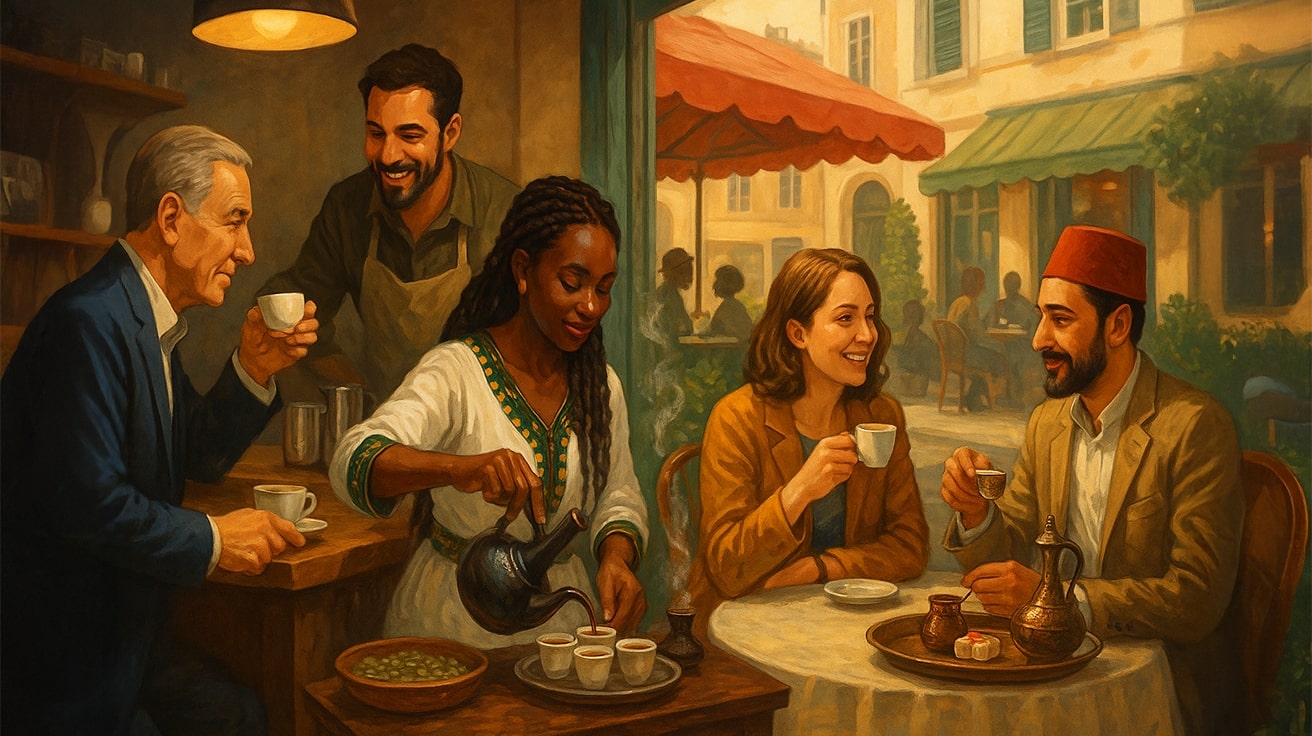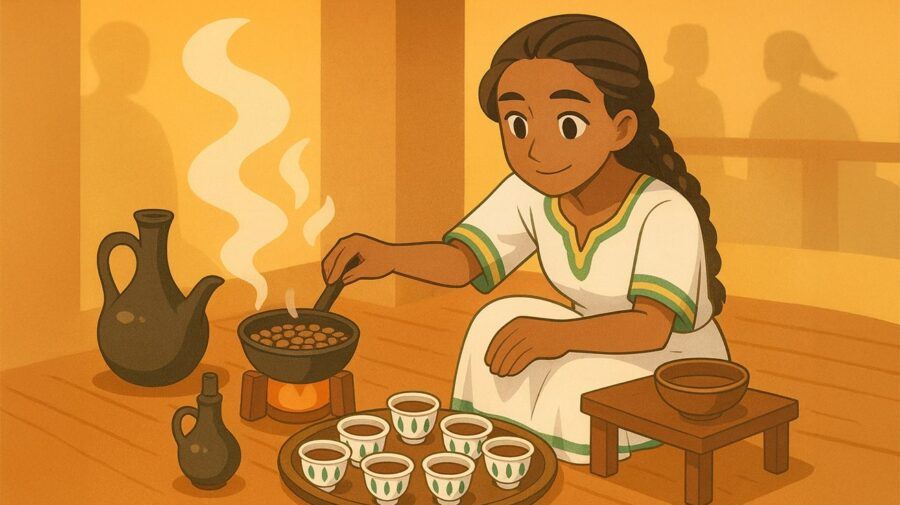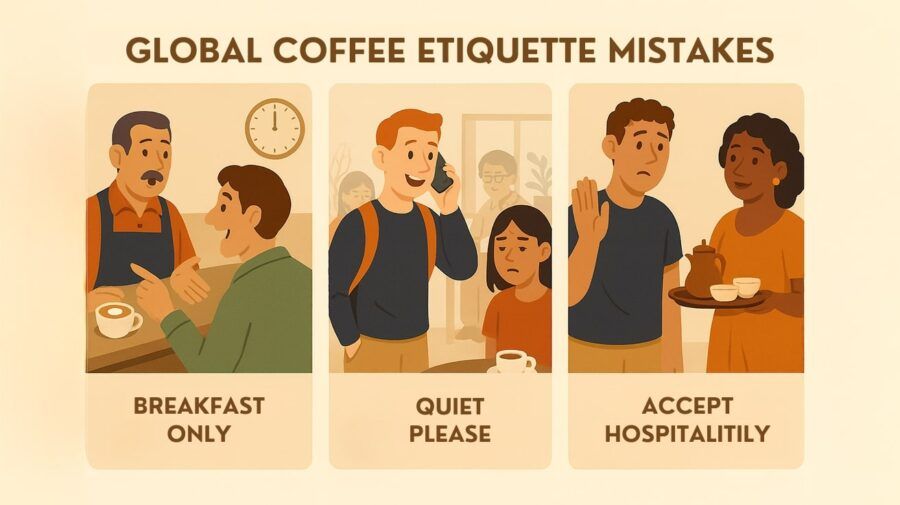Coffee Etiquette Around the World: Essential Dos and Don’ts by Country

Affiliate Disclosure: As an Amazon Associate, I earn from qualifying purchases. This post may also contain other affiliate links, meaning I may earn a small commission if you buy through them, at no extra cost to you. Your support helps keep this site running and allows me to continue sharing great content. Thank you!
Coffee unites people across the globe, but it’s amazing how many unwritten rules and habits shape the way each country enjoys its cup. If you’ve ever wondered whether to tip the barista in Japan or felt awkward lingering over an espresso in Rome, you’re not alone.
This guide to coffee etiquette around the world will show you how to sip like a local, avoid classic tourist mistakes, and truly connect with coffee culture wherever you travel.
Whether you’re planning a trip or just curious about global coffee customs, you’ll learn the essential dos and don’ts by country, fascinating cultural stories, and tips for blending in, so every cup feels like an invitation, not a misstep.
What Is Coffee Etiquette?
Coffee etiquette is a set of social habits and subtle rules around how people order, drink, pay for, and enjoy coffee in different places.
This covers:
- How you order and drink coffee (what’s polite, what’s expected, what’s odd)
- Timing and rituals (when you’re “supposed” to order certain drinks)
- Social interaction (how to greet staff, whether to chat or keep quiet)
- Payment and tipping (paying before or after, tipping or not)
- Table manners (how long to linger, who pours, even where to sit)
Why does it matter? Because coffee isn’t just a beverage, it’s a gateway to local culture.
Blending in with coffee customs helps you:
- Show respect for your hosts and baristas
- Avoid awkward misunderstandings
- Unlock richer travel experiences (sometimes even better service)
- Connect with locals and share memorable moments
Learning these global coffee traditions isn’t about “getting it perfect.” It’s about joining in, on their terms, and discovering what makes each country’s coffee scene unique.
Country-by-Country Coffee Etiquette Guide
Italy
Italy is the spiritual home of espresso and the birthplace of some of the world’s strictest coffee customs. Italian coffee etiquette is all about tradition and efficiency; locals take their coffee seriously, but rarely linger. If you’re curious about recreating Italian espresso at home, see my guide to the best manual espresso machines for hands-on home baristas.
Dos:
- Order an espresso (“un caffè”) and drink it standing at the bar for the true local experience.
- In many traditional cafés, pay at the cashier first, then take your receipt to the barista.
- Enjoy milk-based drinks like cappuccino only before noon, never after lunch.
Don’ts:
- Don’t order a “latte” unless you want a glass of plain milk.
- Don’t sit for hours with a tiny espresso; Italians sip quickly and move on.
- Don’t expect a menu full of syrupy flavored drinks.
Fun fact: Italians almost never order a double espresso. They’ll just order a second single if they want more.
Food and coffee habits go hand in hand here. A quick pastry at the counter is the norm for breakfast, and the rhythm of speedy coffee stops helps Italians keep their day flowing smoothly.
France
France’s café culture is iconic, think leisurely mornings, flaky pastries, and café terraces. But French coffee etiquette is built on subtle rituals and social respect.
Dos:
- Always greet the staff (“Bonjour, Madame/Monsieur”) before ordering.
- Order at the counter in busy cafés; in sit-down spots, wait for table service.
- Embrace the slower pace; coffee is to be enjoyed, not rushed.
Don’ts:
- Don’t expect takeaway coffee; most locals drink in.
- Don’t split the bill for a single coffee; pay as one group if you’re together.
- Don’t rush out as soon as you finish; lingering is part of the charm.
Fun fact: A “café crème” (French-style cappuccino) is traditionally enjoyed only at breakfast.
The importance of the sidewalk terrace can’t be overstated. Sitting outside, facing the street, is how locals soak up the atmosphere. Coffee here is about slowing down and people-watching; don’t expect fast food pacing.
Japan
Japan’s coffee culture blends quiet hospitality with meticulous attention to detail. Whether you’re in a retro Kissaten or a modern café, the rules are all about respect and harmony.
Dos:
- Be polite and quiet; keep your voice low and respect the peaceful atmosphere.
- In traditional settings, accept your cup with both hands as a gesture of gratitude.
- Follow house rules; some cafés may even have a dress code.
Don’ts:
- Don’t talk on your phone or disrupt others with loud conversation.
- Don’t tip; service is included, and tipping can be seen as awkward.
- Don’t rush; take your time and savor the experience.
Fun fact: Classic Japanese coffee houses (Kissaten) often have their own unique rules, no laptops, no photography, and sometimes even no talking during certain hours.
The attention to detail here goes all the way to the cup: many Kissaten serve each drink in its own carefully chosen mug, making every order feel special.
Ethiopia
Coffee isn’t just a drink in Ethiopia; it’s a cherished social ceremony with deep cultural roots. Accepting coffee is about honoring friendship and hospitality.

Dos:
- Accept the invitation to a coffee ceremony; it’s considered an honor.
- Take part in all three rounds if you can; each cup has its own meaning.
- Eat any snacks or bread offered alongside the coffee.
Don’ts:
- Don’t refuse coffee or rush the ceremony; patience is part of the tradition.
- Don’t pour your own cup; wait for your host.
Fun fact: The third round of coffee, called “baraka,” is said to bring a blessing to those who share it.
Coffee ceremonies can turn into impromptu gatherings, with neighbors dropping in, snacks passed around, and stories shared long after the last cup is poured. It’s an experience where respect and patience are truly valued.
United States / Canada
North American coffee culture is all about speed, convenience, and personalization, but there are still a few unwritten rules.
Dos:
- Tip your barista, especially in independent cafés.
- Use first names in smaller shops; friendly, casual vibes are the norm.
- Take your coffee to go if you like; it’s perfectly acceptable.
Don’ts:
- Don’t expect classic espresso etiquette in a diner; filter coffee is king.
- Don’t cut in line during the morning rush.
- Don’t be surprised by the “bottomless cup”; it’s a North American staple.
Fun fact: The idea of a “bottomless” mug, unlimited refills for one price, was invented in American diners.
Nowadays, coffee culture is evolving with more focus on specialty brewing, community spaces, and even coffee ‘cupping’ events for those exploring new flavors.
Mexico
Mexico’s café culture is deeply social and flavored by tradition. Café de olla (spiced coffee in a clay pot) is a staple, especially in traditional markets or family-run spots.
Dos:
- Greet staff and guests; pleasantries are part of the ritual.
- Try the house specials, especially café de olla.
- Linger and chat; cafés encourage lingering.
Don’ts:
- Don’t skip greetings or pleasantries.
- Don’t down your coffee and run; take your time.
Fun fact: Café de olla is often brewed with cinnamon and piloncillo (unrefined cane sugar), creating a uniquely comforting taste.
Whether in a bustling market or quiet café, sharing coffee here is tied deeply to hospitality and warmth.
Australia
Australia’s café scene is fiercely independent and creative, think world-class flat whites and a devotion to quality over quantity. Etiquette here is relaxed but has its own quirks.
Dos:
- Order at the counter and pay before you sit; table service is rare.
- Try local favorites like the flat white or long black.
- Ask for recommendations; Aussie baristas love to talk about coffee.
Don’ts:
- Don’t expect drip coffee; espresso-based drinks are the standard.
- Don’t ask for a “regular coffee”; be specific about what you want.
- Don’t linger during the morning rush; grab a seat outside peak times.
Fun fact: Australia’s obsession with microfoam and milk texture gave birth to the now-famous flat white.
Australian baristas take genuine pride in their craft. Many cafés roast their own beans, ask what’s special, and you might hear a story or get a sample of something new.
Turkey
Turkish coffee is thick and rich and is served with a side of ceremony. The etiquette reflects centuries of tradition; every step matters.
Dos:
- Accept your coffee with a slight nod and a “thank you” (teşekkürler).
- Sip slowly and enjoy the ritual; it’s about conversation as much as caffeine.
- Let the grounds settle, don’t stir or gulp the last sip.
Don’ts:
- Don’t add milk; Turkish coffee is always served black, sometimes with sugar.
- Don’t decline if offered; it can be considered rude.
- Don’t rush, take your time, and savor the moment.
Fun fact: In some Turkish households, reading the coffee grounds left in your cup is a centuries-old tradition for telling fortunes.
The social side of coffee here can be magical, expect hospitality and maybe even a lesson in reading coffee grounds if you’re curious.
Curious what fortune-telling with Turkish coffee actually looks like? Here’s a quick video that explores the history and magic behind this centuries-old ritual.
Global Faux Pas: Common Coffee Mistakes Travelers Make
No matter how adventurous you are, it’s easy to trip up on local coffee customs. Here are the mistakes travelers most often make, and how to sidestep them:
- Ordering milky drinks at the wrong time: In Italy and France, cappuccinos, lattes, and café crème are for breakfast; ordering one after noon is a tourist giveaway.
- Speaking loudly or taking calls: In Japan and Scandinavia, quiet conversation (or silence) is the rule; loud talk or phone calls draw stares.
- Skipping the social ritual: In Ethiopia or Turkey, refusing coffee or leaving early disrupts important traditions. Coffee is about hospitality.
- Ignoring local payment customs: Paying before ordering is standard in Australia; in France or Italy, you may pay after, or at a separate counter.
- Missing tipping rules: In the U.S. and Canada, tipping baristas is appreciated; in Japan or Scandinavia, tipping can be awkward.

Learning these little rules isn’t about perfection; it’s about showing respect, getting the best local experience, and sometimes even earning a smile (or a second cup).
How to Blend In Like a Local (Anywhere)
Want to avoid looking like a tourist and actually enjoy coffee the way locals do? Here are some universal tips:
- Watch what locals do before you order: Mirror their moves for instant credibility.
- Keep your order simple: Skip complicated customizations unless they’re common.
- Match the mood: Adapt your volume and pace to fit the café’s vibe.
- Respect the ritual: In some places, coffee is about connection; in others, it’s a quick stop, read the room, and enjoy.
- Smile and be gracious: A genuine thank you goes a long way, even if you fumble the order.
When in doubt, blend in by following the crowd. Most people appreciate visitors who show respect for their customs.
Coffee Etiquette Myths & Curiosities
Even seasoned travelers get tripped up by coffee customs. Here are some common questions and quirky myths:
Is It Really Rude to Order a Cappuccino After Noon in Italy?
Yes, by local standards, Italians see milky coffees as breakfast-only. Expect a raised eyebrow (and maybe a story to tell later).
Why Do Some Countries Serve Water with Coffee?
In places like Italy, Turkey, and Scandinavia, water is served to cleanse your palate before (and sometimes after) each sip. It’s a sign of hospitality.
Do I Always Have to Finish the Cup?
Not always. In Ethiopia or Turkey, leaving a little coffee at the bottom is normal; sometimes it’s practical, sometimes cultural.
Are You Supposed to Tip for Coffee Everywhere?
No, Tipping is expected in the U.S. and Canada, sometimes appreciated in Australia, but uncommon (or even awkward) in Japan and much of Europe.
Can You Really Tell Fortunes with Coffee Grounds?
In Turkey, reading the grounds (tasseography) after finishing your coffee is a centuries-old tradition. It’s more about fun and conversation than actual fortune-telling.
Absolutely! Most baristas enjoy sharing their favorites or seasonal brews. Just be friendly and open to suggestions.
Final Thoughts
Coffee isn’t just a drink; it’s a global language, spoken in rituals, gestures, and tiny acts of hospitality. Whether you’re sipping espresso at a crowded bar in Rome, lingering over a café au lait in Paris, or sharing a traditional ceremony in Ethiopia, how you drink often matters as much as what’s in your cup.
The real joy of exploring coffee etiquette around the world is letting local customs shape your experience. Sometimes, a small nod to tradition or a willingness to slow down leads to the most memorable moments of your trip.
Want to bring a taste of global coffee culture home? Check out my roundup of the best coffee souvenirs from around the world.
Have you ever made a coffee faux pas or discovered a surprising ritual abroad? Share your stories, surprises, or tips in the comments. I’d love to hear how coffee culture surprised you!
